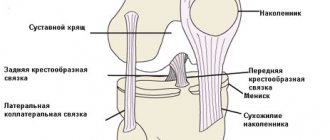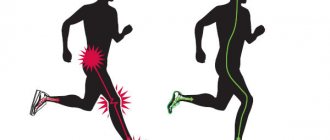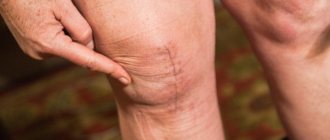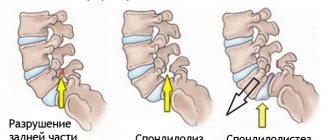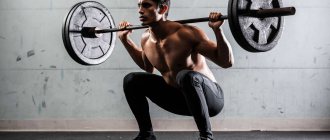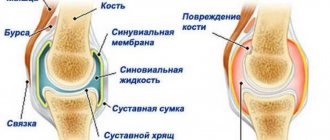Sevmassage » Articles
Your knees are some of the strongest joints in your body , they support your body weight, providing stability when walking, running, turning, jumping and lifting.
Your knees also allow you to move to sit and stand. Unfortunately, your knees are also the most commonly injured joints in your body. The knee joint is formed at the intersection of four bones , the femur, tibia and fibula, and the patella, which slides over the top of the joint as you bend your knee.
Your knees are supported and completely stabilized by the surrounding ligaments and muscles. The main ligaments are: the cruciate ligaments, which run through the anterior (front) and posterior (back) knees, and the collateral ligaments are located on both sides of the knee. If you follow sports, you've probably heard of athletes with knee injuries to the anterior cruciate ligament, which connects the femur to the lower leg and runs just under the kneecap.
In addition to ligaments, your knees are supported by several large muscle groups. The quadriceps are the large muscles on the front of the thigh that straighten the knee when walking or standing. On the back of your leg, your hamstrings run behind your knee and attach to two leg bones, the tibia and fibula, and are responsible for the bend of your knee. The remaining muscles associated with the support and movement of the knee are the hip contractors (outer thighs) and hip adductors (inner thighs), the calf muscles, and the buttocks.
Why an anatomy lesson? Besides direct injury, the main cause of knee pain is instability caused by weak muscles and ligaments surrounding the joint. Want to strengthen and stabilize your knees and reduce knee pain while increasing your range of motion? Strengthen supporting muscle groups.
You can reduce or eliminate knee pain and improve your strength and mobility through exercise. The following low-impact exercises have been selected to improve your strength and restore balance to the muscles that support and stabilize your knees:
Wall slides
Strengthens the quadriceps and the tissues and ligaments above your knee.
How to do it: Stand 30-40 cm from the wall and lean back until your back touches the wall. Place your arms at your sides with your palms facing the wall for support. Slowly lower the wall until your knees reach a 30-degree angle and hold this position for 10-15 seconds, slowly return to the vertical position and repeat at least 5-10 times.
Precautions: Don't lower your body to the point that your knees go beyond your toes, if they do, stop and move your feet a little further away from the wall.
What to do
The optimal treatment for knee pain, if you want to avoid surgery and drugs, involves finding the real, biomechanical cause of the disease. In many cases, knee pain is associated with improper position of the sacrum, spinal dysfunction, flat feet, etc. Each patient has his own individual set of dysfunctions, which are formed from birth and even earlier. There cannot be a single universal recipe here, and therefore the best solution would be to contact a specialist.
When treating knee pain, you should not rely on fancy ointments, powerful analgesics, joint injections, or folk remedies. By removing a symptom, they do not eliminate the original causes that caused the dysfunction. As long as the disease can be stopped and treated conservatively, individual osteopathic treatment is the optimal choice.
Sitting straighten your legs
Strengthens quadriceps and hip flexors.
How to do it: Start by placing two chairs facing each other, sit in one and place one foot on top of the other. Now straighten that leg and lift your leg 4-6 centimeters from the chair and hold it for at least 5-10 seconds and then relax. Do this exercise 5-10 times for each leg and try to extend the time you keep your leg off the chair. Variations: If chairs are not available, you can perform this exercise on the floor with one leg straight and the opposite leg bent on the floor. As you get stronger, you can add ankle weights to increase the difficulty.
Sitting bent leg raises
Strengthens the quadriceps just above the knee and the ligaments surrounding the joint.
How to do it: While sitting in a chair, straighten one leg in front of you, but stop without covering your knee. Hold your raised leg in this position for one minute, this will also engage and strengthen your hip flexors. Now, without moving your hip, bend at the knee until your leg forms a 45-degree angle and hold this position for another 30 seconds. Relax and repeat with the opposite leg. Replace until you complete 4 reps on each leg.
Hip abduction
Strengthens the hip abductor muscle
,from the center line.
How to do it: Lie on your side with your legs bent and your arm bent at the elbow to support your head. Bend your bottom knee to support your body and, keeping it straight, lift your top leg (at the top) slowly up and away from the mat. Hold at the top for 5-10 seconds, slowly lower and repeat for 12-15 repetitions.
Cautions: Do not swing or lift your leg, do not use momentum. Slowly lift, hold, lower and repeat. Once you get stronger, consider adding ankle weights.
Hamstring strain
Strengthens your hamstrings and the tissue behind the knee.
How to do it: Grasp the back of a chair or low wall and bend one knee as you bring your foot toward your butt. Focus on keeping your knee pointing to the floor throughout the movement. Hold your leg near your buttocks for 5-10 seconds and then slowly lower your leg until it just barely touches the floor and do 12-15 repetitions and up to 1-3 exercises for each leg. Again, as you get stronger, you can add ankle weights to increase the difficulty and effectiveness.
Step by step
Strengthens your entire lower body and all the muscles that support your knees.
How to do it: Stand in front of a sturdy box, bench or step 30 to 40 cm high and place one foot on the step and slowly rise up, keeping your knee aligned above your foot. Step up with the other leg until you take a step, then step one leg back and down, then the other. The sequence should be up, up, down, down. As you get stronger, you can increase your step height and difficulty. Perform your activities for a minimum of 1 minute and gradually increase the time with each workout.
Cautions: If you experience knee pain or are unable to maintain a steady pace for the desired time, reduce your stride height.
How to train with sore knees without causing harm
Knees need to be taken care of, especially damaged ones, but this does not mean that you urgently need to give up sports and fitness. An ordinary light jog on asphalt in sneakers with thin soles can lead to pain; it is important not to transform it into chronic pain. The ointments recommended at the pharmacy alone cannot be used - for example, stretching and yoga are good preparations and prevent sprains and have a positive effect on joint health. You can find classes near your home or work and plan your workouts in our free Sport Priority mobile app.
It’s good to use all the remedies at once: regularly devote time to warming up, cooling down, and stretching. If you still cannot avoid pain in the knee joint, you should slightly change your usual exercises - a modified (lighter) workout will stabilize the knee, since it is stability that is needed most in this risk area.
Barbell exercises
The most common knee injuries are damage to the menisci, tears of the ligaments that strengthen the knee joint and fractures of the bones that form it. Most often they appear due to underdevelopment of the surrounding muscles and strong shock load.
There is a myth that to keep your knees healthy you should forget about squats. On the Internet, there are also recommendations to replace the exercise with a bench press and focus on developing the quadriceps (the large quadriceps muscle on the front of the thigh). Experienced fitness trainers advise not to trust rumors: focusing on quadriceps training can only do harm.
The fact is that this muscle can increase the load on the anterior cruciate ligament, while it suffers most often in knee injuries. Another common injury is spraining: obviously, stretching something that is sprained is not entirely beneficial. It is more important to train the back of the thigh, this will reduce the load on the damaged areas.
If squats are painful, replace them with deadlifts.
Do not reduce the amplitude of the exercises; it is better to stop doing them altogether. Let's take the same squat as the most painful exercise for knee pain - fellow bodybuilders will advise you not to bend your knees completely. Don't listen to them, even if you find it easier to do squats.
By squatting not to full depth, we get significantly less tired. In this case, there is a chance to start doing exercises with more weight than your knees can handle. In addition, the 90-degree angle for the knee joint is the most unstable - the parts of the joint move very easily relative to each other.
Do not put additional stress on the ligaments; instead, continue to squat all the way to the end, but with significantly less weight. You know, it’s better to forget about the “half squat” altogether - find a professional trainer, let him show you the correct deep squat technique with the right position of the pelvis and hips. You won’t notice how you switch from light weights to heavy weights, and your knees will only become stronger.
Use a ladder or step . The exercise is a classic lateral lift, just smoothly step up onto the step/step one leg at a time, fully straighten your leg at the knee, and descend slowly as well. Use weights - take a dumbbell with a small, equal weight in each hand.
Lying down isometric exercises are also good for sore knees . For example, a bridge with one support: lie down on the mat, bend your legs at the knees, put your hands on the floor and keep your balance with them. Lift your buttocks off the floor so that your hips and torso form a straight line. Extend one leg at the knee, making the shin a continuation of the torso-thigh line. Hold for a few seconds and repeat the exercise on the other side.
Do a version of the “deadlift” with dumbbells or a bar on one leg: stand up straight, bend one leg at the knee and begin to lean forward, moving the bent leg back and up. Bend your supporting leg to an angle of no more than 10 degrees, do not keep it straight. Hold this position, straighten up and smoothly change legs.
Aerobic exercise
Until the pain subsides (that is, the inflammation goes away), some cardio exercises will have to be postponed. Not only the obvious running and jumping , but also active dancing , including salsa, zumba and others, as well as classic aerobics with step . Trampolines too - soft landings do not meet the requirements for joint stability.
Water is one of the best ways to stay in shape and take care of your feet. Water aerobics, any type of swimming and activity in the pool are your best friends . You can try both therapeutic water aerobics and regular ones, without a therapeutic effect.
Walking, Nordic walking, cycling, cycling and an elliptical trainer also provide a fairly high level of activity, strengthen the muscles around the knee joint and relieve stress on it. Scandinavian sticks will transfer part of the load to your hands. But it’s better not to get up on skis: although there is also unloading of the legs, the knees will be too mobile. Maybe you haven’t tried any of these types of training yet? Take a look at our Sport Priority app and find free trial classes for yourself.
What else should you give up in the gym?
From any type of fitness and exercise that may cause joint displacement. These include all kinds of twists, body turns on straight legs, as well as exercises on moving and unstable platforms and surfaces. So, exclude bosu machines, fitballs, balls and similar equipment.
Forward lunges should be done with caution, as perfect technique is difficult to achieve. It is better to do backward lunges, this is a much healthier option. Regeneration of ligaments occurs more actively during increased blood circulation; warm up the joints with repeated gentle repetitions, without reaching the pain threshold. Warming gels and ointments will also not be superfluous as an assistant.
stationary bike
Strengthens the hamstrings and knee ligaments while increasing non-impact range of motion.
How to do it: Your seat needs to be adjusted to the correct height to ride your bike safely and efficiently, your hips will contract. If you go too low, you can hurt your knees and shorten your muscles (and range of motion). Make sure that when your foot is at the bottom of your pedal stroke, your leg is almost straight but your knee is maintaining a 15 degree angle. Your starting cycling time should be 10 minutes per day and add an extra minute each day until you reach your daily goal.
Squats: benefits
Squats work the quadriceps, glutes, calves, hamstrings, lower back muscles, and abdominal muscles. Thanks to the participation of the back muscles, squats improve coordination.
Yellow — high load Red. - maximum load
Regularly performing squats leads to enlargement of the buttocks, as well as to an improvement in their shape - the buttocks become taller and rounder. At the same time, the quadriceps also increase, the hips become toned and more prominent. Some variations of squats place more emphasis on the glutes, while others place more emphasis on the thighs.
Are squats effective for losing weight?
Yes, like any other exercise. The body doesn’t care how exactly you burn calories, the main thing is to burn them. But squats have an undeniable advantage: while expending calories, you simultaneously improve your body shape by working your gluteal muscles. Their sagging goes away, the riding breeches that upset women disappear, the butt becomes less “blurred”, and therefore the body seems more slender.
How many calories are burned when squatting? The calculation can be done as follows: multiply your weight in kilograms by 0.1. The result obtained is the number of calories you lose per minute of doing squats. If, for example, your weight is 60 kg, then in a minute of squats you burn 6 kcal, and in 10 minutes - 60 kcal. If you perform frequent, intense squats, you will burn calories faster. Squats with weights also increase the load.
Quadratus muscles
Strengthen the ligaments and tissues surrounding the knee and quadratus femoris muscles.
How to do it: This isometric exercise, strengthens the area around the knee without actually moving the leg or knee, and helps to fully straighten the knee. While you're lying on your back or sitting upright on the floor, keep your leg and knee straight as you extend the quadriceps muscle on the front of your thigh, and focus on pushing through your knee as you "lock" your knee straight. You will see your kneecap move upward as you tighten (squeeze) your thigh muscles. Hold for at least 3 seconds and perform 12-15 repetitions on each leg.
Short arcs
Strengthens your quadriceps and surrounding ligaments, a good knee rehabilitation exercise after a knee injury or surgery.
How to do it: Lying on the floor or in bed, roll up a towel and place it under your knee. Focus on pulling your toes toward your body as you extend your quads and slowly lift your leg off the bed. Keep your knee in contact with the roller and hold your leg for 3-5 seconds and repeat 10-15 times for each knee. To increase difficulty and effectiveness, use a thicker rolled towel followed by ankle weights.
Harm and danger of squats: truth or myth?
In the 50-60s of the 20th century, studies were conducted on the effect of physical exercise on muscles and joints. These studies found that regular squats, especially with weights, can have a negative impact on your knees.
Even performing squats correctly has been reported to stretch the knee tendons in all directions. The knees begin to weaken and hurt as stability in the knee joint is lost. These findings even influenced the development of training programs in the US Army: some units completely abandoned squats.
Squats had a bad reputation for a long time, but after a while this exercise got a second chance. In the late 80s, scientists from the University of Alabama conducted a new study. They measured the knee ligament stability of 100 volunteers. Over the course of eight weeks, some people did squats, some did not. After this, the stability of the participants' knees was measured again. No difference was recorded. That is, the knees of those who squatted were not damaged.
After this, the knees of weightlifters and powerlifters were examined. It turned out that the knee joints of these athletes are no less stable than those of people involved in any other sports.
However, despite the restoration of the reputation of squats in sports circles, experts still recommend refraining from performing this exercise in the early stages of recovery from a knee injury, and even more so after knee surgery. Under no circumstances should you perform squats if the exercise is accompanied by knee pain!
It is believed that squats are most dangerous for the knees, but this is not true! Doing squats incorrectly can be dangerous for the spine. However, the dangers of squats for the back are discussed mainly only in the case of performing exercises with weights. Especially if the weight is located on the shoulders (squats with a barbell on the shoulders). When squatting with very high weights, there is a risk of ruptured discs and even spinal fractures.
Therefore, squats with weights on the shoulders should only be performed under the guidance of a qualified trainer and only after consultation with a doctor! Unless you are an experienced powerlifter, bodybuilder, or weightlifter, do not attempt heavy squats on your own at home!
The researchers concluded that a slight forward bend of the torso when squatting reduces the risk of intervertebral disc rupture and fracture, but the likelihood of vertebral body displacement sharply increases. Thus, bending over is not 100% effective back protection when squatting with heavy weights. Therefore, you need to increase weight gradually and slowly. Moreover, this must be done under the guidance of a trainer and a doctor.
Squats with light weights in your hands are safer, but a gradual increase in load is also important here.
Seated knee march
Strengthens your quadriceps while increasing your knee flexibility and range of motion. Another good rehabilitation exercise for an injured knee joint.
How to do it: While sitting in a chair, place both feet on the floor in front of you. Raise one knee and leg slowly as you point your knee towards the ceiling, lower and repeat with the opposite leg. You walk with "high" knees while sitting to avoid pressure and weight. Continue for at least 1 minute and do this exercise any time you feel stiffness in your knees.
Previous post Exercises for correcting kyphoscoliosis of the thoracic spine
Next entry Widow's hump: what is it and how to get rid of it?
How to squat correctly
September 8, 2010
The simplest and most accessible exercise for anyone to strengthen their leg muscles is squats.
The simplest and most accessible exercise for anyone to strengthen their leg muscles is squats. They do not require special equipment and can be performed at any convenient time. Marina Makarova, head of the exercise therapy department of the Center for Restorative Medicine and Rehabilitation of the Treatment and Rehabilitation Center of the Ministry of Health and Social Development of Russia, tells how to squat correctly.
How to do it right
The head of the exercise therapy department at the Center for Restorative Medicine and Rehabilitation of the Treatment and Rehabilitation Center of the Ministry of Health and Social Development of Russia, Marina Makarova, tells: - how to sit correctly in the office, - how to do exercises in the office, - how to remain a healthy car enthusiast, - what the right shoes should be.
Based on the effect on the leg muscles, all squats are divided into two large groups: with support on the entire foot or only on the toes.
Exercises that support the entire foot
allow you to stretch the posterior calf muscles.
And, if for men these exercises are quite simple, then for women who walk in heels all day, squats must be performed carefully - their lower leg muscles are overloaded and can be injured. In addition, those who suffer from frequent back pain should be careful when squatting. After all, as a rule, pain and tension in the back muscles are accompanied by tension in the calf muscles. That is why you first need to squat at a slow pace
, carefully listening to your feelings.
To perform the first exercise, which allows you to train the muscles of the lower leg and thigh, place your feet shoulder-width apart and your hands on your waist. Squat, resting your entire foot on the floor. Choose a comfortable pace and depth and do at least 20-30 squats. If knee pain occurs during squats, the exercise can be simplified a little. Squat down, stretching your arms straight forward. This will help you maintain balance and reduce stress on your knees. Another simplified option is squats with your arms spread to the side. You can make squats a little more difficult by placing your feet not shoulder-width apart, but foot-width apart. To maintain balance when squatting, extend your arms straight forward. If pain in the knee joints occurs while performing the exercise, squats can not be performed very deeply. So that the muscles only indicate movement, and the knee joint does not bend with maximum amplitude. Squats resting on the toes
allow you to not stretch the lower leg muscles too much. They are more comfortable than full-foot exercises, although they increase the stress on the small joints of the toes. Shift your body weight onto your toes. Stretch your arms forward when squatting and return them to your belt when returning to the starting position. The pistol exercise, in which squats are performed with emphasis on one leg, is a good test for determining muscle strength in the legs and coordination of movements. Place your supporting leg on the floor with your entire foot, and when squatting straight, pull the other one forward. To maintain balance, you can help yourself with your arms by stretching them forward. If it is difficult to maintain your balance, carry out your first training sessions using some kind of support for support.
Tags:
- Home workouts
- Legs
- Makarova
- Squats
- Testing
1 comment • To leave a comment you must be an authorized user
- Colorized has seen and practiced a completely different technique in a variety of clubs—feet wider than shoulder-width apart, resting on the heel, you can even lift your toes off the floor, your knees are not fully extended. This exercise is usually done with weights - a body bar on the shoulders, but if it’s difficult, you can do it without it. True, this is in group classes, as the instructors recommend in the gym, I don’t know.

